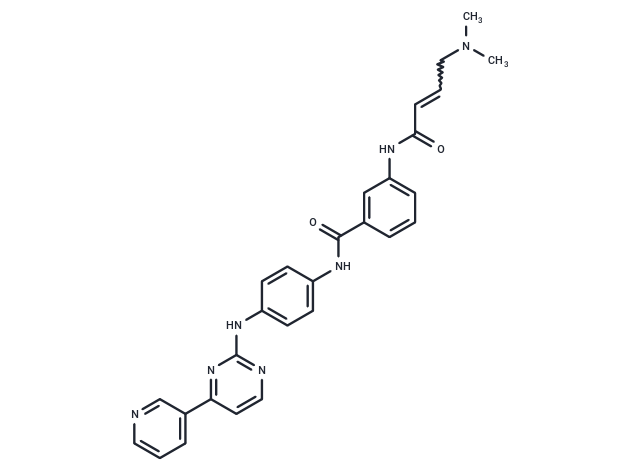Shopping Cart
Remove All Your shopping cart is currently empty
Your shopping cart is currently empty
JNK-IN-7 (JNK inhibitor) is a selective JNK1/2/3 inhibitor (IC50: 1.54/1.99/0.75 nM). It can also inhibit phosphorylation of c-Jun, which is a substrate of JNK kinase.

| Pack Size | Price | USA Warehouse | Global Warehouse | Quantity |
|---|---|---|---|---|
| 1 mg | $89 | In Stock | In Stock | |
| 2 mg | $161 | In Stock | In Stock | |
| 5 mg | $238 | In Stock | In Stock | |
| 10 mg | $306 | In Stock | In Stock | |
| 25 mg | $550 | In Stock | In Stock | |
| 50 mg | $792 | In Stock | In Stock | |
| 100 mg | $1,080 | In Stock | In Stock | |
| 1 mL x 10 mM (in DMSO) | $258 | In Stock | In Stock |
| Description | JNK-IN-7 (JNK inhibitor) is a selective JNK1/2/3 inhibitor (IC50: 1.54/1.99/0.75 nM). It can also inhibit phosphorylation of c-Jun, which is a substrate of JNK kinase. |
| Targets&IC50 | JNK1:1.54 nM, JNK3:0.75 nM, JNK2:1.99nM |
| In vitro | JNK-IN-7 is a relatively selective JNK inhibitor in cells, binding to JNK1, 2, 3, IRAK1 (IC50=14.1 nM), YSK4 (IC50=4.8 nM), ERK3 (IC50=22 nM), PIK3C3, PIP5K3, and PIP4K2C[1]. In HCT116 cells, TNF stimulation for 24 and 48 hours significantly decreases divalent metal-ion transporter 1 (DMT1) expression, a process that JNK-IN-7 can notably counteract[2]. |
| Kinase Assay | A375 cells are pre-treated with 1 μM JNK-IN-7 for the indicated amounts of time. Remove the medium and wash 3 times with PBS. Resuspend the cell pellet with 1 mL Lysis Buffer (1% NP-40, 1% CHAPS, 25 mM Tris, 150 mM NaCl, Phosphatase Inhibitor Cocktail). Rotate end-to-end for 30 min at 4°C. Lysates are cleared by centrifugation at 14000 rpm for 15 min in the Eppendorf. The cleared lysates gel filtered into Kinase Buffer (0.1% NP-40, 20 mM HEPES, 150 mM NaCl, Phosphatase Inhibitor Cocktail, Protease Inhibitor Cocktail) using Bio-Rad 10DG colums. The total protein concentration of the gel-filtered lysate should be around 5-15 mg/mL. Cell lysate is labeled with the probe at 5 μM for 1 hour. Samples are reduced with DTT, and cysteines are blocked with iodoacetamide and gel filtered to remove excess reagents and exchange the buffer. Add 1 volume of 2X Binding Buffer (2% Triton-100, 1% NP-40, 2 mM EDTA, 2X PBS) and 50 μL streptavidin bead slurry and rotate end-to-end for 2 hours, centrifuge at 7000 rpm for 2 min. Wash 3 times with 1X Binding Buffer and 3 times with PBS. Add 30 μL 1X sample buffer to beads, heat samples at 95°C for 10 min. Run samples on an SDS-PAGE gel at 110V. After transferred, the membrane is immunoblotted with JNK antibody[1]. |
| Cell Research | JNK-IN-7 is prepared in DMSO and stored, and then diluted with appropriate medium before use[2]. Intestinal epithelial cell line (HCT116) is cultured in DMEM medium, supplemented with 10% heat-inactivated fetal bovine serum (FBS), penicillin (100?U/mL) and streptomycin (100?g/mL), 2?mM L-gentamycin, and 50?μM 2-ME. These cells are stimulated with TNF (20?ng/mL), LPS (100?ng/mL), and IFN-γ (20?ng/mL), respectively. After 24 or 48?h of culture, cells are harvested followed by extraction of total RNA, and the levels of DMT1 mRNA are analyzed by qRT-PCR. To determine the mechanisms of TNF involved in regulating DMT1 expression, JNK-IN-7 (1?μM), NF-κB inhibitor (BAY 11-7082, 1?μM), and caspase-3/8 inhibitor (Z-DEVD-FMK, 50?μM) are also added into the culture medium. After 48?h of culture, cells are then collected to detect the expression of DMT1 by qRT-PCR[2]. |
| Synonyms | JNK inhibitor |
| Molecular Weight | 493.56 |
| Formula | C28H27N7O2 |
| Cas No. | 1408064-71-0 |
| Smiles | CN(C)CC=CC(=O)Nc1cccc(c1)C(=O)Nc1ccc(Nc2nccc(n2)-c2cccnc2)cc1 |
| Relative Density. | 1.301 g/cm3 (Predicted) |
| Color | White |
| Appearance | Solid |
| Storage | Powder: -20°C for 3 years | In solvent: -80°C for 1 year | Shipping with blue ice/Shipping at ambient temperature. | ||||||||||||||||||||||||||||||
| Solubility Information | DMSO: 28.88 mg/mL (58.51 mM), Sonication is recommended. | ||||||||||||||||||||||||||||||
| In Vivo Formulation | 10% DMSO+40% PEG300+5% Tween 80+45% Saline: 2 mg/mL (4.05 mM), Sonication is recommended. Please add the solvents sequentially, clarifying the solution as much as possible before adding the next one. Dissolve by heating and/or sonication if necessary. Working solution is recommended to be prepared and used immediately. The formulation provided above is for reference purposes only. In vivo formulations may vary and should be modified based on specific experimental conditions. | ||||||||||||||||||||||||||||||
Solution Preparation Table | |||||||||||||||||||||||||||||||
DMSO
| |||||||||||||||||||||||||||||||
| Size | Quantity | Unit Price | Amount | Operation |
|---|

Copyright © 2015-2025 TargetMol Chemicals Inc. All Rights Reserved.